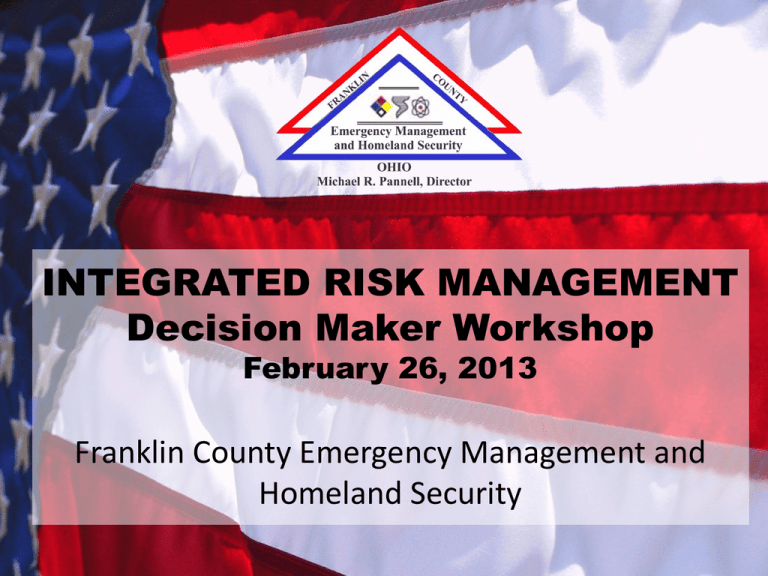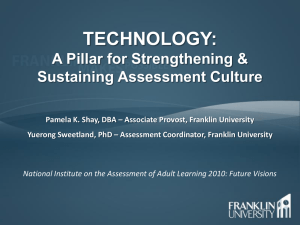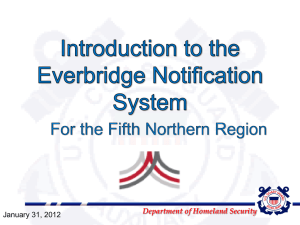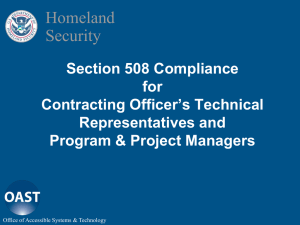2013 DM Workshop - Franklin County Emergency Management
advertisement

INTEGRATED RISK MANAGEMENT Decision Maker Workshop February 26, 2013 Franklin County Emergency Management and Homeland Security Agenda 1. 2. 3. 4. 5. 6. 7. Authorities Integrated Risk Management Overview Risk/Capability/Gap Formula Risks Capabilities Gaps Recommended Actions FCEM&HS Emergency Management Authority Franklin County Emergency Management and Homeland Security (FCEM&HS) is authorized under Chapter 5502 of the Ohio Revised Code and organized under the 1988 Countywide Agreement to coordinate countywide all-hazards emergency management and disaster preparedness functions for the 42 local government jurisdictions of Franklin County. • “…are designed or undertaken to minimize the effects upon the civilian population caused or that could be caused by any hazard and that are necessary to address mitigation, emergency preparedness, response, and recovery.” 3 FCEM&HS Core Competencies Ohio Revised Code: 5502.21 – 5502.51 • Warning Systems: “The control and use of emergency communications, lighting, and warning equipment and systems.” • Emergency Operations Center: “The development and construction of emergency operations centers for the conduct and support of coordination, direction, and control activities.” • Resources: “The development of resource initiatives.” • Recovery: “All activities required and necessary to return an area to its former condition to the extent possible following the occurrence of any hazard.” 4 FCEM&HS Core Competencies Ohio Revised Code: 5502.21 – 5502.51 • Planning: “The development of an all-hazards emergency operations plan that has been coordinated with all agencies, boards, and divisions having emergency management functions.” • Training: “The recruitment, retention, and training of personnel.” • Exercises: “The preparation and conduct of an annual exercise of the all-hazards emergency operations plan.” • Citizen Preparedness: “Activities that may be necessary for survival and the overall health, safety, and welfare of the civilian population.” • Grants: Administration of SHSP, EMPG, Citizen Corp, HMEP, PUCO. 5 Integrated Risk Management (IRM) • In 2009, FCEM&HS changed the Homeland Security paradigm for Franklin County by implementing a riskbased approach to better prepare for, respond to and recover from all-hazards. • This innovative, risk-based approach resulted in a partnership between FCEM&HS, Ohio EMA and policy makers from Department of Homeland Security (DHS). • FCEM&HS was selected by DHS as a pilot program to develop an Integrated Risk Management philosophy and program. 6 Integrated Risk Management (IRM) • Taking a risk-based approach, assessing our capabilities, and identifying our gaps, is instrumental in our ability to shape the emergency management and homeland security strategic planning and policy-making process. • Integrated Risk Management is a process to fuse, unify, and inform the Homeland Security Enterprise. • You are all a strategic part of the Homeland Security Enterprise. 7 “Silo-ed” Approach NonProfits EMA NGOs Fire LE Citizens Federal State Private Sector CEOs Decision Makers Health Integrated Approach EMA Fire LE Emergency Partners Citizens State and Federal Partners Federal Local Jurisdictions State Health Decision Makers NonProfits Private Sector CEOs NGOs Homeland Security Enterprise • Homeland Security Enterprise (HSE) is a “whole community” approach. • Utilizes partnerships among emergency management, law enforcement, public health, local/state/federal government, private sector, nongovernmental organizations, faith-based & community-based organizations, and the public. • Federal guidance focus is on allhazards preparedness; local HSE partners must share info regardless of threat or hazard, man-made or natural. • Foundation of IRM is understanding the Risk Capabilities Gaps Decision-Making process. Local Emergency Partners FCEM&HS State and Federal Partners • Participation by Decision Makers in the Homeland Security Enterprise is key to fully realizing integrated risk management. Jurisdictional CEO’s Communication & Coordination Risk/Capability/Gap Formula Decision Maker Education and Engagement Risk Capabilities Franklin County Threat Hazard Identification & Risk Assessment (THIRA) Franklin County Core Capability Assessment Gaps Franklin County Gap Analysis Recommended Results Actions Resource Allocation, Planning, Training, Exercises, Funding Priorities Homeland Security Enterprise Decision Maker Review & Updates 11 Integrated Risk Management Components Capability Assessment Risk Assessment Enhancement • • • • • Develop likely, worse-case scenarios Identify risk factors Weight risk factors Score risks Update Risk Assessment based on new methodology and scoring risks • • • Identify priority Core Capabilities based on scenarios Develop Capability Survey based on THIRA results Assess Capability current levels with preparedness goals based on survey results Gap Analysis • • • • Recommended Actions Use Capability • Develop Gap Assessment to Closures, i.e. actions identify Gaps to close identified Prioritize to gaps ensure the higher • Prioritize Gap priority Gaps are Closures based on accurately survey results and identified stakeholder input Identify Solution • Develop Areas to determine Recommended ways to close the Actions from Gap Gaps Closures to present Finalize with to Decision Makers written Gap Analysis Risk Process • Develop likely, worse-case scenarios • Identify risk factors • Weight risk factors • Score risks • Update Risk Assessment based on new methodology and scoring risks 13 Risk Results • • • • • • • • • • • • • • • • 2010 Risks Flooding Severe Winter Weather Dam Failure Terrorism Infectious Disease Tornadoes Severe Summer Weather Extreme Heat Hazardous Materials Incidents Drought Utility Interruptions or Failures Invasive Species Air and Water Pollution/Contamination Transportation Accident – Aircraft Civil Disturbance Earthquake • • • • • • • • • • • • • • • • • • 2013 Risks Tornadoes Dam Failure Flooding WMD Terrorist Incident Cyber-Terrorism Infectious Disease Severe Winter Weather Hazardous Material Incident Transportation Accident - Aircraft Severe Summer Weather Utility Interruptions or Failures Civil Disturbance Lone-Wolf Terrorist Risk scoring process Air and Water Pollution/ can be found in the Contamination Risk Assessment Extreme Heat Executive Summary Drought & Methodology Invasive Species (Tab 4) Earthquakes Capability Process • Identify priority Core Capabilities based on scenarios • Develop Capability Assessment Survey based on the Threat and Hazard Identification and Risk Assessment (THIRA) • Assess Capability current levels with preparedness goals • Identify “Top 13” Capabilities based on survey results THIRA can be found in Tab 5 & Survey Results in 15 Tab 6 Priority Core Capabilities PREVENT PROTECT MITIGATE RESPOND RECOVER Planning Planning Planning Planning Planning Public Information and Warning Operational Coordination Public Information and Warning Operational Coordination Access Control and Identity Verification Public Information and Warning Operational Coordination Public Information and Warning Operational Coordination Public Information and Warning Operational Coordination Community Resilience Critical Transportation Economic Recovery Long-Term Vulnerability Reduction Risk and Disaster Resilience Assessment Threats and Hazard Identification Environmental Response / Health and Safety Fatality Management Services Health and Social Services Infrastructure Systems Infrastructure Systems Mass Care Services Natural and Cultural Resources Forensics and Attribution Intelligence and Information Sharing Interdiction and Disruption Screening, Search, and Detection Cybersecurity Intelligence and Information Sharing Interdiction and Disruption Physical Protective Measures Risk Management for Protection Programs and Activities Screening, Search, and Detection Supply Chain Integrity and Security Mass Search and Rescue Operations On-Scene Security and Protection Operational Communications Public and Private Services and Resources Public Health and Medical Services Situational Assessment Housing Capability Assessment Results Core Capabilities Priority Sequence “Top 13” 1—Public Information & Warning 2—Operational Coordination 3—Planning 4—Mass Care Services 5—Critical Transportation 6—Infrastructure Systems 7—Cybersecurity 8—On-scene Security & Protection 9—Mass Search & Rescue Operations 10—Operational Communications 11—Environmental Response/Health & Safety 12—Public Health & Medical Services 13—Intelligence & Information Sharing Capability Prioritization process can be found in the Gap Analysis (Tab 7) 17 Gap Process • Use Capability Assessment to identify Gaps • Prioritize to ensure the higher priority Gaps are accurately identified • Identify Solution Areas to determine ways to close the Gaps • Finalize with written Gap Analysis 18 Gaps Analysis Results Core Capability Public Information & Warning Operational Coordination Planning Mass Care Services Critical Transportation Infrastructure Systems Cybersecurity Corresponding Gap Closures Continue outreach with elected officials and various organizations to ensure there are programs to support and provide prompt and accurate information to the public, including people with functional needs. Assign Corrective Actions from the After Action Report/Improvement Plan (AAR/IP) to the appropriate department or agency and encourage departments to follow through with Improvement Plans and ensure Corrective Actions are completed. Continue to encourage, educate and generate more involvement and support from elected officials. Provide cross-training of staff for emergency partners to ensure backup positions are prepared and trained to handle additional responsibilities. Effectively implement mutual aid assistance agreements and compacts. Encourage training for chief executives and other key officials in Franklin County and from local jurisdictions to participate in the Homeland Security Enterprise. Build organizational structures and relationships, establish Entire Gap Closure coordination linkages, and develop and implement list can be found in training programs to enhance Cybersecurity among the the Gap Analysis whole community in Franklin County. (Tab 7) 19 Recommended Actions • Implement an Annual Decision Maker meeting to review IRM progress and continue to encourage, educate and generate more involvement and support from elected officials • Continuation of training and multi-discipline, regional exercises • Maintain organizational structures and current working groups to ensure emergency management and homeland security partners continue to collaborate despite declining grant funding • Develop a Cybersecurity Workgroup to build organizational structures and relationships among the whole community in Franklin County 20 Risk/Capability/Gap Formula Decision Maker Education and Engagement Risk Capabilities Franklin County Threat Hazard Identification & Risk Assessment (THIRA) Franklin County Core Capability Assessment Gaps Franklin County Gap Analysis Recommended Results Actions Resource Allocation, Planning, Training, Exercises, Funding Priorities Homeland Security Enterprise Decision Maker Review & Updates 21 QUESTIONS/DISCUSSION Franklin County Emergency Management and Homeland Security










